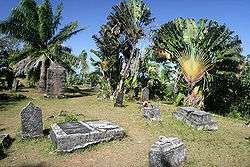Île Sainte-Marie
Nosy Boraha [ˈnuʃ buˈrahə̥], previously known as Île Sainte-Marie (and still popularly known by travellers as such), is an island off the east coast of Madagascar, to which it belongs. The main town is Ambodifotatra. The island forms an administrative district within Analanjirofo Region, and covers an area of 222 km2. It had a population estimated at 26,547 in 2013.[1]
.png)
Government
The island is organized as the city (commune urbaine) and district of Nosy Boraha in Analanjirofo Region, and is part of the nation of Madagascar.
The population has changed over the centuries. Originally it was Austronesian, as on the larger islands of Madagascar and then reverted to pirate control, however most inhabitants now are similar to the rest of the northeast coast of Madagascar.
Geography
This island is 60 kilometres (37 miles) long and less than 10 kilometres (6.2 miles) wide.
An airport serves the town.
Whale watching
The channel between Nosy Boraha and Madagascar is known for whale watching. Substantial groups of humpback whales (Megaptera) migrate from the Antarctic to this breeding ground. The whales find conditions here that are well suited to their courtship and favourable for the growth of their young and before their annual migration to colder water. Although scarce, southern right whales,[2][3][4][5] as a part of the recolonization of their former ranges, are known to appear along the coast from time to time.
Pirates

Ile Sainte-Marie, or St. Mary's Island as it is known in English, became a popular base for pirates, starting with Adam Baldridge in 1691[6] and ending with John Pro in 1719, in the 17th and 18th centuries due to several reasons: it was not far from the maritime routes along which ships returning from the East Indies sailed in transit, their holds overflowing with wealth; it was provided with bays and inlets protected from storms; and finally, it had abundant fruit and was situated in quiet waters. Legendary pirates including William Kidd, Robert Culliford, Olivier Levasseur, Henry Every, Abraham Samuel and Thomas Tew lived in the île aux Forbans, an island located in the bay of Sainte Marie's main town, Ambodifotatra. Many of them would found a family line. Numerous vestiges of this history remain on Nosy Boraha, but at this time the remains have not been yet identified.
The utopian pirate republic of Libertalia was also rumored to exist in this area, although the republic's existence, let alone its location, has never been proven.
Diving
Free from sharks, the lagoon of the island is endowed with significant coralline growth. Its underwater fauna is conserved as a natural heritage and popular diving site in the Indian Ocean.
On 7 May 2015, a large 55 kg (121 lb) "silver" ingot, which was believed to be Captain Kidd's treasure, was found off the coast of the island.[7] After further analysis, UNESCO determined that the piece actually consisted of 95% lead; they judged it to be "a broken part of the Sainte-Marie port constructions."[8]
Traditions
On Nosy Boraha, the inhabitants are attached to traditions. The social or family events are faithfully linked to practices invoking the ancestors' spirits. The wealth and variety of these rituals underline the authenticity and depth of the "Saint-marien" cultural identity.
In popular culture
The island is the setting for the fourth Uncharted game, which was released for the PlayStation 4.[9] In the game, the main characters explore the island while on a quest to discover the rumored pirate utopia of Libertalia and the fictitious bounty of the famed pirate Henry Avery.
Fauna and flora
The insular character and the coralline soil encouraged various adaptations, as much of animal as of plant structure. Thus, Sainte Marie is endowed with a rich fauna and flora. Sainte-Marie has several species of lemur as well as numerous orchid species, among which is the "Queen of Madagascar" (Eulophiella roempleriana). The island was the only place where Delalande's coua, a non-parasitic cuckoo, was known to occur; this species became extinct in the late 19th century, probably due to predation by feral cats.
Gallery
- The island's paved road runs up the west coast.
- Madagascar's first church was built here by the French.
- The pirate cemetery is a popular tourist destination.
- Dugout canoes ferry passengers between Ste. Marie and Île aux Nattes.
- View of Île aux Nattes from Ste. Marie.
.jpg) Rare southern right whale at Île Sainte-Marie.
Rare southern right whale at Île Sainte-Marie.
See also
References
- Institut National de la Statistique, Madagascar.
- http://brogio-a-mada.over-blog.com/article-22645763.html
- http://elodiemarie.blogspot.jp/2013/09/sainte-marie-madagascar-partie-3.html
- http://wanaloo.pagesperso-orange.fr/AAPStGilles/baleine2009.htm
- http://passionoceans.unblog.fr/2012/03/04/juste-magnifique/
- John Franklin Jameson, Privateering and Piracy in the Colonial Period: Illustrative Documents (New York, 1923), p. 180
- Maranzani, Barbara. "Has Captain Kidd's Treasure Been Found?". History Channel. A&E Television Networks. Retrieved 7 May 2015.
- "UN dismisses Captain Kidd 'treasure' find in Madagascar". BBC News. BBC News. Retrieved 16 July 2015.
- "Uncharted 4 Teaser video". YouTube.
External links
| Wikimedia Commons has media related to Île Sainte-Marie. |